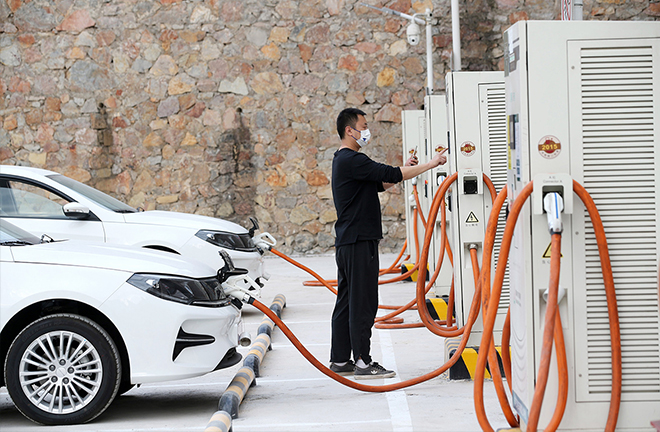China contributes to global climate governance

A driver charges his electric car at a charging station in Qianqiang District, Chongqing Municipality, on Nov. 10. Photo: CFP
The 27th Conference of the Parties to the United Nations Framework Convention on Climate Change (COP27) closed in Sharm el-Sheikh, Egypt, on Nov. 20. In a recent interview with CSST, scholars agreed that addressing climate change and realizing green transformation bring both enormous challenges and opportunities, and China’s realization of its carbon goals will benefit the country and the world by extension.
Achievements and limits of COP27
The establishment of the Loss and Damage Fund was a highlight of COP 27. “After decades of pushing, this is a momentous victory for climate-vulnerable developing countries,” said Antony Froggatt and Guo Jiangwen, senior research fellows from the Environment and Society Program at Chatham House in the UK.
However, the COP27 decision on the Fund does not address such issues as the amount and sources of funding. Froggatt and Guo noted that the international community, particularly developed countries, needs to take urgent measures to fulfill the long-delayed commitment of $100 billion a year in funds for developing countries for climate adaptation and financing.
Energy transition is a key factor in combating climate change. However, Froggatt and Guo observed insufficient progress on the energy transition both in and around COP27. There appears to be little forward movement on phasing out fossil fuels, they said.
“The theme of COP27 was ‘implementation,’ which was unfortunately more of a slogan in terms of many of the outcomes and a number of issues that received attention before the conference,” they said, pointing out that the implementation of climate finance and increased funding for climate adaptation did not show adequate progress.
Challenges and opportunities
To achieve carbon neutrality by 2050, Froggatt and Guo emphasized that the world must reduce greenhouse gas emissions by at least a quarter over the next decade. Making progress towards this goal will inevitably come with some short-term economic costs, especially significant investment needed, but these costs will pale in comparison to the many long-term economic and social benefits of climate change mitigation.
“Taking China as an example, our research from UK-China climate risk assessment program reveals that direct losses from climate disasters already account for 0.4% of China’s GDP, with the impact of indirect and non-disaster losses yet to be quantified,” they said. Under existing commitments, global temperature will rise about three degrees centigrade by 2100; climate losses will account for 5% of China’s GDP and cumulative climate-related losses will reach $189 trillion. However, the carbon neutrality target would avoid more than 80% of climate losses by 2100, holding climate losses within 1–2% of GDP and avoiding more than $134 trillion in cumulative climate losses between 2020 and 2100.
Significance of China’s carbon goals
At the World Economic Forum Annual Meeting 2022 in Davos, Switzerland, in May, Xie Zhenhua, China’s special envoy for climate change, outlined a number of “proactive and concrete” actions China has taken to address climate change, and stressed the nation’s solemn commitment to have CO2 emissions peak before 2030 and achieve carbon neutrality before 2060.
China’s carbon goals are very impressive and important, Jim O’Neill, senior advisor and former chair of Chatham House, told CSST. “Given the scale of the climate challenge and China’s importance to the world, it would be brilliant if China succeeds.” O’Neill also noted that these goals are very difficult to achieve.
Despite the challenges, O’Neill said that a serious move to peak carbon use and replace carbon-intensive energies presents endless opportunities for business and government investment. The so-called “positive multiplier effect” from investing in alternative energies could be hugely positive. For example, China is already showing good signs of this. “If nations really could develop excellent infrastructure for electric charging cars, then the boom in electric cars could accelerate even more, and this would be a massive stimulant for existing auto providers as well as newcomers,” O’Neill said.
In China, the green transition is a transformation of the way in which energy and natural resources are used, Froggatt and Guo said. China’s “dual carbon” strategy is reshaping the relationship between the economy—including social development—and the environment. To cope with climate change and achieve the “dual-carbon” goals, the most important action is to force the structural transformation and upgrading of the economy, energy, and industry, especially to promote the “energy revolution.” In order to meet the carbon goals, there needs to be a major restructuring of existing high-carbon energy systems and corresponding lifestyles and a comprehensive green transformation of economic and social development.
“China is growing into a global leader in the manufacturing and deployment of renewable energy and the circular economy, largely in response to its own energy and resource security concerns, but also provides materials and equipment as well as experience for the rest of world,” Froggatt and Guo said. Driven by continuous green investment, China has taken its technological innovations in renewable energy, electric vehicles, and other fields to new heights over the past decade. Through international cooperation, China has also played an important role in global green development by manufacturing low carbon technology and sharing its technology and experience with different countries, benefiting the global green transition.
Edited by CHEN MIRONG
